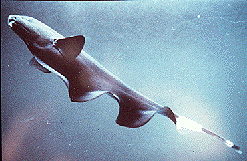South American Gynotiforms: Conductance as Communication
Biology 342 Fall 2011
Moriah Gottman and Misha Naiman
The South American Gymnotiform (common name: The South American Knifefish)
The name refers to the general slender shape of the fish, its elongated anal fin and its tapered tail where its electric organ is centered. The knife fish has no pelvic, caudal or dorsal fin, relying solely on this anal fin for movement. These fish also posses electric organs which allow them to send extremely weak electric stimuli, which acts as a rudimentary communication system that they use primarily to navigate their way around their enviornement, locate mates and members of their own species. While the electric organ is usually derived from muscle cells, the electric organs in adult apteronotids are actually derived from their electromotor neurons in the PNS.


Figure 1. Anatomy of a common fish. All electric fish have this bodily structure. Figure 2. A gymnotiform gleaming in the midafternoon sun.
Tinbergen (1907-1988)
NIko Tinbergen was a 1973 Nobel-Prize winning ethologist and ornithologist who is most accredited with organizing the field of animal behavior into four overarching categories on the dimensions of proximate v. ultimate and snapshot v. longterm. The proximate v. ultimate dichotomy represents the differentiation between the lifetime of an individual in a species versus the evolution of the entire species. The snapshot v. longterm dichotomy refers to the difference between the moment to moment display of a behavior and the lifetime over which that behavior is displayed. The four categories are as follows (see figure 2), from top to bottom and left to right: mechanism (snapshot of a behavior displayed in an individual, therefore also proximate), ontogeny (of a behavior over an individual's lifetime, also proximate), adaptive value (snapshot of the usefulness of a behavior to the species' survival/reproductive fitness, an ultimate explanation), and evolution (the process of the phylogenetic evolution of a behavior through the species' history, ultimate and longterm). The different categories of Tinbergen are relevant to electric organ discharge (EOD) of gymnotiforms because the behavior has been studied in all of these realms. As a diverse taxa, gymnotiforms and mormyriforms both are useful for examining electric conductance from the perspective of both intra and interspecies variation.
| Snapshot | Longterm | |
| Proximate | Mechanism | Ontogeny |
| Ultimate | Adaptive Value | Phylogeny |